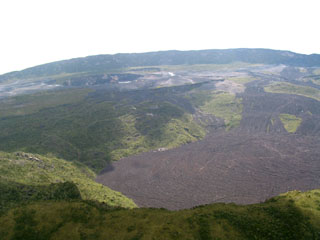Report on Nyamulagira (DR Congo) — 30 December-5 January 2010
Smithsonian Institution / US Geological Survey
Weekly Volcanic Activity Report, 30 December-5 January 2010
Managing Editor: Sally Sennert.
Please cite this report as:
Global Volcanism Program, 2009. Report on Nyamulagira (DR Congo) (Sennert, S, ed.). Weekly Volcanic Activity Report, 30 December-5 January 2010. Smithsonian Institution and US Geological Survey.
Nyamulagira
DR Congo
1.408°S, 29.2°E; summit elev. 3058 m
All times are local (unless otherwise noted)
According to news articles, Nyamuragira erupted on 2 January from a fissure on the SE flank. Park rangers reported hearing a loud explosion in the early morning before seeing flowing lava. By 3 January, the lava flow had traveled 4.6 km, was 15 m wide, and had burned about 10 hectares of forest in a non-populated area of the Virunga National Park.
Geological Summary. Africa's most active volcano, Nyamulagira (also known as Nyamuragira), is a massive high-potassium basaltic shield about 25 km N of Lake Kivu and 13 km NNW of the steep-sided Nyiragongo volcano. The summit is truncated by a small 2 x 2.3 km caldera that has walls up to about 100 m high. Documented eruptions have occurred within the summit caldera, as well as from the numerous flank fissures and cinder cones. A lava lake in the summit crater, active since at least 1921, drained in 1938, at the time of a major flank eruption. Recent lava flows extend down the flanks more than 30 km from the summit as far as Lake Kivu; extensive lava flows from this volcano have covered 1,500 km2 of the western branch of the East African Rift.
Sources: UN Organization Mission in the Democratic Republic of the Congo (MONUC), CNN, UN News Centre, Agence France-Presse (AFP)

